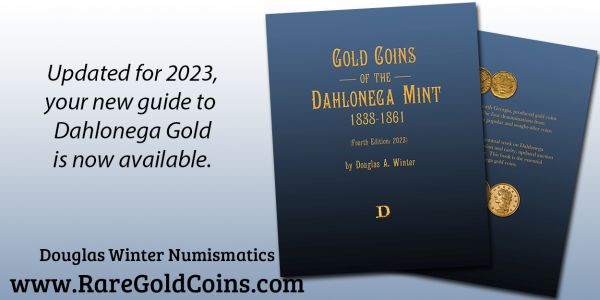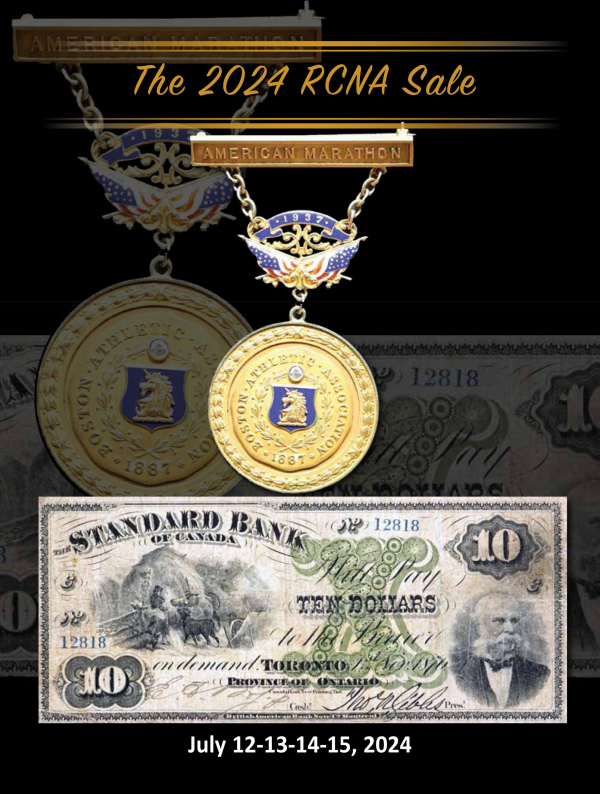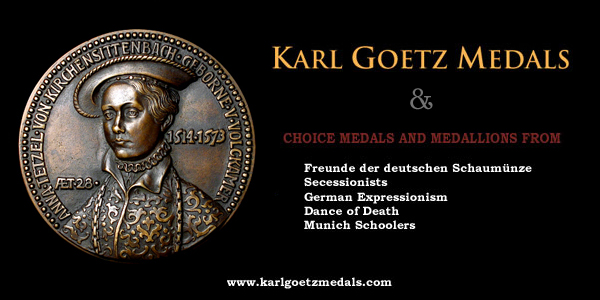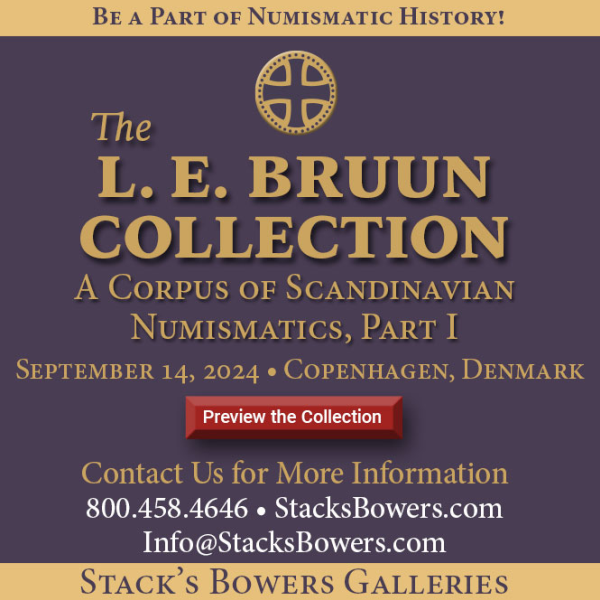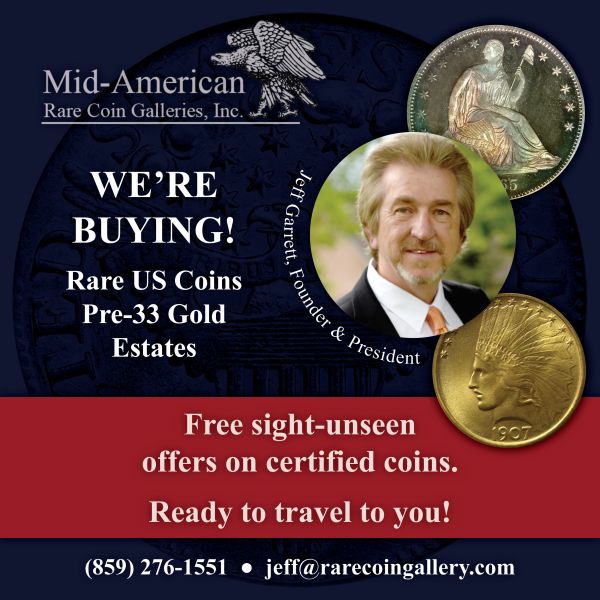
Visit our NBS Sponsors



About UsThe Numismatic Bibliomania Society is a non-profit association devoted to the study and enjoyment of numismatic literature. For more information please see our web site at coinbooks.org SubscriptionsThose wishing to become new E-Sylum subscribers (or wishing to Unsubscribe) can go to the following web page link MembershipThere is a membership application available on the web site Membership Application To join, print the application and return it with your check to the address printed on the application. Print/Digital membership is $40 to addresses in the U.S., and $60 elsewhere. A digital-only membership is available for $25. For those without web access, write to: Jeff Dickerson, Treasurer AsylumFor Asylum mailing address changes and other membership questions, contact Jeff at this email address: treasurer@coinbooks.org SubmissionsTo submit items for publication in The E-Sylum, write to the Editor at this address: whomren@gmail.com BUY THE BOOK BEFORE THE COINSale CalendarWatch here for updates! |
- WAYNE'S WORDS: THE E-SYLUM JUNE 23, 2024
- NBS ACTIVITIES AT THE ANA CONVENTION
- NEW BOOK: 1878 P 7 TAIL FEATHER ATTRIBUTION GUIDE
- ORIENTAL NUMISMATIC SOCIETY SUMMER 2024
- VIDEO: WESTERN MINT LIBERTY SEATED COINAGE
- STAN KESSELMAN INTERVIEW, PART ONE
- SUNKEN DIE ERRORS
- NOTES FROM E-SYLUM READERS: JUNE 23, 2024
- HIGGINS MUSEUM SALES AND SEMINAR
- VOCABULARY TERM: PORCELAIN
- THE COLLECTOR'S DISPOSITION DILEMMA
- NUMISMAGRAM MEDAL SELECTIONS: JUNE 23, 2024
- ATLAS NUMISMATICS SELECTIONS: JUNE 23, 2024
- SOCIETY OF THE CINCINNATI BADGE OFFERED
- DAVISSONS: EARLY DATED COINAGE
- THE TCNC JULY 2024 RCNA SALE
- WAYNE'S NUMISMATIC DIARY: JUNE 23, 2024
- PEGASUS ON ANCIENT COINS
- CHARLESTON SLAVE BADGES ONLINE
- 1864 MASONIC ENGRAVED HALF DOLLAR OFFERED
- BRITISH ARMY DROPS CHINESE-MADE BADGES
- ON FAROUK COLLECTION PAPER MONEY
- LAWSUIT: DENVER MINT OFFICER ASSAULTED NURSE
- LOOSE CHANGE: JUNE 23, 2024
- FANATICS LAWSUIT ALLEGES MONOPOLY
Content presented in The E-Sylum is not necessarily researched or independently fact-checked, and views expressed do not necessarily represent those of the Numismatic Bibliomania Society.
WAYNE'S WORDS: THE E-SYLUM JUNE 23, 2024
 New subscribers this week include:
Eric Lindholm, courtesy Daryl Haynor.
Welcome aboard! We now have 7,255 subscribers.
New subscribers this week include:
Eric Lindholm, courtesy Daryl Haynor.
Welcome aboard! We now have 7,255 subscribers.
Thank you for reading The E-Sylum. If you enjoy it, please send me the email addresses of friends you think may enjoy it as well and I'll send them a subscription. Contact me at whomren@gmail.com anytime regarding your subscription, or questions, comments or suggestions about our content.
This week we open with NBS activities at the upcoming ANA convention, one new book, updates from the Newman Numismatic Portal, notes from readers, and more.
Other topics this week include Morgan dollar varieties, Liberty Seated coinage, sunken die errors, fixed price and auction offerings, the Society of the Cincinnati, early dated coinage, Pegasus on ancient coins, Charleston slave badges, and Farouk paper money.
To learn more about California Pioneer Fractional Gold, Stan Kesselman, the Polish levitating coin, US Mint coin bags, the Alfred Nobel silver medal, the Spingarn medal, the September Pope, and the godfather of Melrose, read on. Have a great week, everyone!
Wayne Homren
Editor, The E-Sylum
NBS ACTIVITIES AT THE ANA CONVENTION
Numismatic Bibliomania Society President Len Augsburger submitted this report on the planned club activities at the upcoming American Numismatic Association World's Fair of Money®. -Editor
 NBS Activities at the ANA Convention
NBS Activities at the ANA Convention
Once again, the ANA Convention will feature a full slate of NBS activities. Our club table on the bourse floor is 1321, conveniently located adjacent to book dealers Kolbe & Fanning and Charles Davis. Tom Harrison will be hosting the club table on Tuesday, with Jeff Dickerson taking over on Wednesday. Jeff has been learning the fine arts of bookbinding and will be doing a demo of box building for attendees. Boxes will be suitably sized to contain back issues of the The Asylum. This is your chance to create a one-of-a-kind commemorative of NBS history!
The NBS Symposium annually showcases presentations related to new books. This year’s installment features author Robert D. Leonard, speaking on the upcoming third edition of California Pioneer Fractional Gold, while Len Augsburger will discuss the forthcoming bibliography of Eric P. Newman, to be published by Kolbe & Fanning. This event takes place at 1:00 PM in room 10.
NEW BOOK: 1878 P 7 TAIL FEATHER ATTRIBUTION GUIDE
A new monograph by Leroy Van Allen examines the 1878 P 7 Tail Feather Morgan Dollar variety. -Editor
1878 P 7 Tail Feather Morgan Dollar Attribution Guide
by Leroy Van Allen
 This is to announce that the 1878 P 7 Tail Feather Morgan Dollar Attribution Guide by Leroy Van Allen is now in digital form on Amazon Kindle for only $9.95. It was edited by Michael S. Fey, Ph.D.
This is to announce that the 1878 P 7 Tail Feather Morgan Dollar Attribution Guide by Leroy Van Allen is now in digital form on Amazon Kindle for only $9.95. It was edited by Michael S. Fey, Ph.D.
This is yet another definitive reference by Leroy Van Allen showing all the things that can differentiate common 1878 7 TF (Tail Feather) Morgan silver dollars from rare die varieties and errors. Indeed, you will be treated to numerous instances of die varieties features along with copious pictures illustrating the differences between the variety/error and a normal 1878 7TF silver dollar. There were four major hub modifications in the first year of Morgan dollar production: 8 TF, 7/8 TF, 7 TF reverse of 1878 with parallel arrow feathers, and 7TF reverse of 1879 with slanted arrow feathers. This book focuses solely on the 7 TF reverse designs.
THE BOOK BAZARRE
ORIENTAL NUMISMATIC SOCIETY SUMMER 2024
The Summer 2024 issue of the Journal of the Oriental Numismatic Society has been published. -Editor
Journal of the Oriental Numismatic Society
Summer 2024
CONTENTS
 Two interesting coins of the Agra tribe
Two interesting coins of the Agra tribe
Devendra Handa
Why did the Elymaean king Kamnaskires IV strike coins at the Ecbatana mint?
Patrick Pasmans
Unfortunate coins indeed: A reply to Cribb et al. in JONS 249
Nikolaus Schindel
Notes on Aksumite coins in southern India
Wolfgang Hahn
A hoard of base silver srimadadivaraha drammas of Bhoja I from Jhelum, Pakistan Gul
Rahim Khan
VIDEO: WESTERN MINT LIBERTY SEATED COINAGE
The David Lisot Video Library on the Newman Numismatic Portal can be found at:
https://nnp.wustl.edu/library/multimediadetail/522852
We highlight one of his videos each week in The E-Sylum. Here's one from 2005 that features Darrell Low & Leonard Augsburger speaking about Seated coinage from the Western mints. -Editor
STAN KESSELMAN INTERVIEW, PART ONE
Greg Bennick's latest interview for the Newman Numismatic Portal is with New York dealer Stan Kesselman. Here's the first of eight parts, where Stan talks about how he got started in numismatics, and dealing with Norman Stack, Harry Bass and Ted Naftzger. -Editor
GREG BENNICK: Hi, everybody. I'm Greg Bennick with the Newman Numismatic Portal, and I am doing an interview today with Stanley Kesselman. I'm excited for this interview. This is going to be absolutely great, and I'm really excited to get started. So, Stan, how are you today?
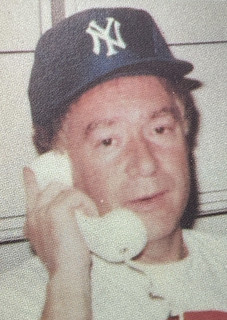 STANLEY KESSELMAN: I'm very fine. The weather's good, and the country's still here, so I'm happy.
STANLEY KESSELMAN: I'm very fine. The weather's good, and the country's still here, so I'm happy.
GREG BENNICK: Good. That's a good start. I agree with that. I like the fact that we're all still here, so let's talk about coins. Tell me about your origins in coins. How did you get started in coins?
STANLEY KESSELMAN: I went from eighth grade, and I changed schools, and I went into ninth grade at a school called New Lincoln, which was situated on 110th Street in New York City between 5th and Lenox Avenue. That's where Central Park ends and Harlem begins. So, it was a very progressive school, and in the school, in my class, they had students who were 13 years old, and they collected coins. And I knew nothing about coins. And one of the boys was named Herbie Sondheim. He had a very famous brother named Stephen.
GREG BENNICK: Yeah, he did.
STANLEY KESSELMAN: Yeah, he did. And Herbie collected coins, and they were the Herring brothers. They collected a set of Indian head pennies, which they must be 80 years old, and they still have the original set, they never ever will sell it. And they became art dealers in the ninth grade, and they made fortunes. They collected the Rembrandt etchings, and they never sell. They just kept it. They have things there for sixty years on their walls. They never sell.
So, I got interested in coins, and I got especially interested in gold coins, because gold was better than copper. It still is. And the mintages of gold coins were much less than copper coins. So, like an 1880 quarter eagle, they made like 2,900 pieces. And a 1909 S-VDB penny, I think the mintage is 500 thousand. So, gold coins always interested me. And I bought one, and then I bought another, and then I bought another. And I went to a Lester Merkin auction. Who was a dealer in New York City, and he wouldn't let me bid, because I was under 18. So, I met a man there with a long beard, and he said he would bid for me, and his name was Walter Breen. So, that's when I first met Walter. And I bought an 1849-D quarter eagle in AU condition, like $58.
So, eventually, by doing this, I ran out of money.
GREG BENNICK: (Laughs)
STANLEY KESSELMAN: But I had an advantage over a lot of people, because a lot of people were married. I'm 17 years old, and they had expenses. I lived at home. I had no expenses. So, my availability for coins, money-wise, was probably equal to somebody, you know, 30, 40 years old in a business. He had to send his kids to college. He had to pay rent. I had no expenses at all. My father never charged me for food. So, I ran out of money, and I sold all my coins.
Then I went to another Lester Merkin auction, and he had an 1884 $20 gold piece in proof. And I paid $6,700 for it, and that was my total capital. I had one coin, and I took it home, and then I got very bored.
GREG BENNICK: What year was this?
STANLEY KESSELMAN: I would say 1967, 1968, something like that. Maybe early….no, it was earlier. Maybe 57. I can't remember. I was born in 44, so 17 and 44 is 61. All right. So, I had the one coin, and I'm out of the coin business, because I couldn't buy anything else. So, I went into Stacks. I was friendly with Norman Stacks. I was friendly with Harvey Stacks. I was friendly with Ben Stacks, and I knew their parents, Morton. And I said I had an 1884 $20 gold piece in proof, and Norman takes out his wallet, picks out a card, and he has around 20 coins on his want list, and this was one of them. So, I gave him the coin to sell, and I made $300 on it. So, now, I had $7,000, and I'm back in business. And I just kept on doing that kind of thing.
GREG BENNICK: That's amazing. Now, you never had a store throughout the years that you were dealing. You always worked in private sales. Isn't that right?
STANLEY KESSELMAN: I never had a store because I'm 18 years old and I went to college at Syracuse. I'm up in Syracuse for four years. Then I went to law school at Fordham and then I went to law school at NYU. I was never a full-time coin dealer. But at the time when I was active, there wasn't much competition. There were maybe three people in the country who would buy gold coins for inventory. No one else would. There were Brownlee and Rowe in Dallas, Texas. They had much more capital than I did. And they were competition.
The other competition was collectors themselves would go to auctions and put things together. And that is where you met your future customers who was at auctions because you bid against them and they come over to you. If you won, they say how much you want for the coin. And if they won the coin, you introduce yourself. So that's how I met Harry Bass and a lot of other people.
Ted Naftzger put together a collection of 20s. He had a lot of money and bought a lot of coins from Abe Kosoff. And he ended up with a lot of proof coins. And his family had an oil company in California. And eventually Chevron bought it. And he had a lot of Chevron stock. And he was an amazing person. He flew his own airplane. He raised cattle. And he had his own island off of California that he owned to raise the cattle. Yeah. And his main passion was large cents. He loved large cents, new varieties. And he always improved his large cents and he always improved his $20 gold coins.
And I remember I was at Syracuse. I had an 1863-S $20 in uncirculated condition, which was rare back then because there was no shipwrecks for the coins. And I sold him an 1863-S $20 in uncirculated for maybe, I don't know, $250. And he gave me his EF coin back for maybe $45 and paid the difference back then.
GREG BENNICK: Unbelievable.
STANLEY KESSELMAN: Yeah. So, I had a few, I had the best customers. And they were all much older than I was, much, much richer, you know. And first time I met Harry Bass at the auction, he said he discovered a new coin. And I said, Harry, what did you discover? He discovered an 1846-D with a D over D on the back, like a double mint mark. And I said, everybody knows that exists. It's in the book. And he said, no, I discovered the $5 one. The one in the book is a quarter eagle. And that's what happened. So, I thought he was stupid in the beginning. And then I found out, then I found out he was brilliant.
And he became the father to our whole generation of gold coin dealers. He taught us how to play backgammon, which he was in the Navy. And we played backgammon all night, but he loved to play for money. So, he would play for like $100 a point, which become a fortune.
GREG BENNICK: Yeah.
STANLEY KESSELMAN: So, Mike Brownlee and I would play against him for $50 a point. And we're playing in New York City. And we're losing $3,000, $6,000, $9,000. He's setting it up. He's setting it up. It's about four in the morning. And finally, we win two big hands and we're up $50. So, I get up, put on my coat, and he's setting up the board. And he says, “Stanley, what are you doing?” I said, “I'm going home.” And he says, “What do you mean you're going home?” I said, “It took all night for me to get even. Now pay me my $25. I get half of the $50. And I'm going home.” He takes the lamp in the room, throws it across the room, and says, “I’ve been New Yorked.” Reaches for his $25. And I'm just so happy to get out of there. It was just wonderful to leave. But he had somewhat of a temper.
GREG BENNICK: Wow. So, he got upset. He got genuinely upset.
STANLEY KESSELMAN: Yes, because he was having such fun for five hours. And after five and a half hours, he was losing. And it gave him no time for revenge. I was just happy to get out of there. You know, with $25, it was a miracle.
GREG BENNICK: That's amazing.
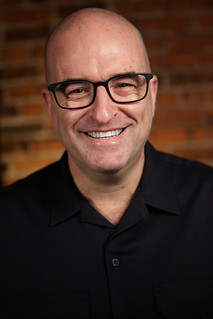 About the Interviewer
About the Interviewer
Greg Bennick (www.gregbennick.com) is a keynote speaker and long time coin collector with a focus on major mint error coins. Have ideas for other interviewees? Contact him anytime on the web or via instagram @minterrors.
To watch the complete video, see:
Stanley Kesselman Interviewed for the NNP by Greg Bennick
(https://nnp.wustl.edu/library/book/638521)
To read the complete transcript, see:
Stanley Kesselman Interviewed for the NNP by Greg Bennick (Transcript)
(https://nnp.wustl.edu/library/book/638520)
SUNKEN DIE ERRORS
Last week Steve Ferber asked about the proper terminology for an edge error he was seeing on a Warren Harding Inaugural medal. We didn't have images in hand at publication time, but Steve later sent them to Heath White who offered an answer. -Editor
NOTES FROM E-SYLUM READERS: JUNE 23, 2024
More on the 1896 Olympics
 Steve Feller writes:
Steve Feller writes:
"Here is a picture of my wife Barb and I at the 1896 marble stadium in downtown Athens. Also, Here is a genuine participant medal too from 1896."
Thanks! Great photo and medal. -Editor
To read the earlier E-Sylum article, see:
NOTES FROM E-SYLUM READERS: JUNE 16, 2024 :
1896 Olympic Medal Copies
(https://www.coinbooks.org/v27/esylum_v27n24a07.html)
Other topics this week include Banknotes in Books, and the levitating coin. -Editor
HIGGINS MUSEUM SALES AND SEMINAR
Curator George Cuhaj writes:
"The Higgins museum will be offering on eBay some US Mint coin bags, non-national banking era bank premiums and other 'stuff' which does not fit into the museum's collecting, exhibition and research goals.
"They will be sold under the seller name of 'CUHAJ" and have a notation in the descriptions as being ex-Higgins for those who want to take a peak. Items will generally close on a Thursday."
VOCABULARY TERM: PORCELAIN
Here's another entry from Dick Johnson's Encyclopedia of Coin and Medal Terminology. -Editor
Porcelain. A clay-based material with a slick slurry giving it a glass-like composition, as a Wedgwood medallion. Porcelain portraits, similar to those in metal, were developed to their pinnacle by Josiah Wedgwood (1730-1795), the famed potter of Staffordshire, England. A contemporary and friend of Matthew Boulton, the two innovators exchanged technical information as Boulton was building his Soho Mint. Wedgwood produced his portrait medallions with small bas- reliefs, either taken from existing medallic art or were created by a famed sculptor of the time, John Flaxman, or by William Hackwood, a staff craftsman of considerable talent.
THE COLLECTOR'S DISPOSITION DILEMMA
E-Sylum Feature Writer and American Numismatic Biographies author Pete Smith submitted this article on his dilemma over the disposition of a very specialized collection. -Editor
 The recent sale of the Wayne Homren Library included lot 455, a corkscrew promoting the
Minneapolis wine business of A. M. Smith. The lot description did not mention that Wayne got
the corkscrew from me.
The recent sale of the Wayne Homren Library included lot 455, a corkscrew promoting the
Minneapolis wine business of A. M. Smith. The lot description did not mention that Wayne got
the corkscrew from me.
This is not a difficult item to acquire. There are currently four similar items on eBay for $27.50, $27.99, $34.95, and $41.19. Their condition appears to be equal or better than the Homren example.
My interest in A. M. Smith goes back to 1978. A co-worker brought in an A.M. Smith bottle he had dug out of a trash heap. The Minneapolis bottle collecting community was very familiar with Smith as a prolific issuer of bottles and advertising promotional items.
NUMISMAGRAM MEDAL SELECTIONS: JUNE 23, 2024
Numismagram's Jeremy Bostwick sent along these four medals from his upload of new material to his site. For all of the new items, please visit https://www.numismagram.com/inventory. -Editor
102765 | SWEDEN. Alfred Nobel silver Medal. Issued 1926. Commemorating the 30th anniversary of his death (45mm, 12h). By E. Lindberg for the Swedish Academy of Sciences. ALFRED NOBEL, bust left in frock coat // Pallas-Athena standing left, spearing tri-headed serpentine Hydra to left; in three lines in exergue, MALA • CORPORIS • ANIMIQVE / SCIENTIA / VINCET (may knowledge conquer the maladies of both mind and body). Edge: SILVER 1926. Ehrensvärd 268. PCGS SP-63. Light graphite gray in hue, with an alluring matte nature. A very rare and desirable issue paralleling the Nobel nominating committee medals, which were also done by Erik Lindberg. From a mintage of just 150 examples. $1,395.
Known for inventing dynamite and bequeathing his fortune in order to fund what would become the Nobel Prizes, Alfred Nobel was a prolific inventor who held over 350 patents. In 1864, he founded the Nitroglycerin Aktiebolaget (Nitroglycerin Corporation), the world's first manufacturer of nitroglycerin (which was vital in his patenting of dynamite a few years later).
As for the artist of this medal, Erik Lindberg was tasked early on with the creation of the Nobel Prize medals in 1901—the Nobel institution for the awarding of these prizes having been newly established. Outside of the Peace Prize (presented instead in Oslo) and the Economics Prize (created much later by the Sveriges Riksbank and not considered part of the Nobel canon), Lindberg's renditions continue to be used for the prize medals to this day, as well as the medals presented to the respective nominating committees. This medal, with its very small mintage of just 150 examples, comes in a larger format of 45mm (rather than 26mm for the nominating committee medals, which continue to be made and awarded). The bust style is also slightly modified from that of the nominating committee medals, and it features a reverse with the same Neoclassical flair as the Nobel Prize medals themselves.
To read the complete item description, see:
102765 | SWEDEN. Alfred Nobel silver Medal.
(https://www.numismagram.com/product-page/102765)
ATLAS NUMISMATICS SELECTIONS: JUNE 23, 2024
Atlas Numismatics has updated their website with 247 coins, medals, and tokens. Selections include the following items. -Editor
1079091 | ROMAN REPUBLICAN. Marc Antony and Octavian. (Imperators and Triumvirs (43-33 BC). Struck circa 41 BC. AR Denarius. NGC AU? (About Uncirculated ?) Strike 5/5 Surface 5/5. Ephesus. 18mm. 4.10gm. M•ANT•IMP•AVG•III•VIR•R•P•C•M•BARBAT•Q•P (MP and AV ligate). Bare head of Marc Antony, right / CAESAR•IMP•PONT•III•VIR•R•P•C•. Bare head of Octavian right with touseled hair and long sideburn. Crawford 517/2; Sydenham 1811; Antonia 51; Barbatia 2; Julia 96.
Beautifully toned and sharply struck; given the star designation by NGC for exceptional eye-appeal.
Ex Numismatica Ars Classica (Zürich), Auction 125 (24 June 2021), lot 479. Ex Bolaffi Sale 34 (Turin) 2019, Lot 389. Includes NGC Photo Cert.
$9,500
SOCIETY OF THE CINCINNATI BADGE OFFERED
In their upcoming June 26th sale, Sotheby's is offering a rare and important Society of the Cincinnati Badge membership badge and certificate. -Editor
(Washington, George) — Society of the Cincinnati
William Floyd's membership certificate and badge, comprising:
 a) Eagle badge, Designed by Pierre Charles L’Enfant (1754–1825), attributed to Duval and Francastel and associated firms, Paris, circa 1784.
a) Eagle badge, Designed by Pierre Charles L’Enfant (1754–1825), attributed to Duval and Francastel and associated firms, Paris, circa 1784.
Gold and enameled eagle with spread wings and legs on green enameled olive branches, head and tail feathers with white and black enamel, red enamel eyes, distinct eyebrows and black beak, head left within green and red enameled laurel wreath of figure-eight design through which a double suspension ring is attached. Oval medallion inset into the eagle’s breast, the motto reads (from 7:00), OMNIA·RELINQT·SERVART·REMPB ?, in the center, two Roman senators present a sword to Cincinnatus against blue enamel sky and green enamel grass, rev., the eagle as above, but head right, the motto reads (from 11:00), ·VIRT·PRAEM·SOCI·CIN·RUM ?, INST·AD·1783, within medallion, Cincinnatus stands facing next to his plow, with sun and palisade behind, enameled blue sky and green ground, (40 x 25 mm); obverse chipping to tailfeathers, some minor losses to red and green enamels of the wreath and branch, the ribbon replaced.
DAVISSONS: EARLY DATED COINAGE
Davissons is holding their E-Auction 49 on June 26th. Here's Allan Davisson's overview of the early dated coinage in the sale. Nice consignment! -Editor
E-Auction 49 closes on Wednesday, June 26th 2024! The sale features a fascinating small consignment of early dated coinage, which Allan discusses below, followed by a brief overview of the rest of the Byzantine, medieval, world, and medal sections.
Dates on coins are “a really big deal.” Add a mintmark on a U.S. coin and it can be even more costly (look up an 1893 Morgan dollar with a small “S” on the reverse…). Though coins had dates on them prior to the 13th century, coins using the calendar numbering system we use today did not appear until 1234 A.D. Though there were a few rare and seldom seen issues earlier, it was not until the 15th century that coins appeared in quantity with dates referencing the calendar we now use.
THE TCNC JULY 2024 RCNA SALE
The Canadian Numismatic Company is offering the Royal Canadian Numismatic Association sale July 12-15, 2024. Here's some information and selected lots. -Editor
Featuring in this auction; An elusive Boston Marathon Gold Medal, a splendid Newfoundland $2 Gold Set and an amazing selection of Maritimes coinage. Two Gold $5's & $10's 6-Coin Sets, A stunning 1890H 50 cents PCGS Choice AU-55, A Superb 1921 25 cents in Gem Mint State-66. A 1920 50¢ Narrow O, PCGS Superb Gem Mint State-66, an 1884 10¢ PCGS Choice Mint State-62, a 1982 $1 Nickel - Constitution UPSET Die / Coin alignment PCGS Gem Mint State-65.
A unique 1876 $10 Standard Bank, a lovely 1924 $5 Queen Mary in Choice VF, a 1935 $1000 Choice UNC-64, a 1935 $25 in Gem UNC-65 and a wonderful selection of the 1935 & 1937 series. In addition, a superb selection of very scarce Proof and Specimen banknotes and several others including Rare Serial number issues and error notes. Again, The “Brown Family” Collection Part III holds a premium selection of rare and carefully chosen banknotes. Two Jewels from The Wildlife Museum Collection is a 1923 $1 banknote set and a 1935 $500 Specimen in Gem UNC-66. Enjoy!
WAYNE'S NUMISMATIC DIARY: JUNE 23, 2024
First, a little catch-up. Last Friday, June 14 (Flag Day!) I spent the afternoon in Baltimore at the Whitman Summer Expo. This is the smallest and slowest of the three annual shows, but still a good opportunity to catch up with people - at least, if you don't arrive late, which I did following a longer than expected pitstop for routine car maintenance.
I parked at the nearby Sheraton hotel and was amused by this sign. Luckily I didn't need to hoof it up that set of stairs.
Once I registered and got into the bourse around 2pm I scouted the periphery and a number of dealers were closing up shop or already gone for the day. Some E-Sylum supporters were still in attendance - I spoke briefly with Julian Leidman, but Wayne Herndon and Jon Sullivan were busy with customers. I talked a while with Melissa Kahn about Robert Powers' latest variety guide books and some ANA Convention medals I was tracking down for a friend.
PEGASUS ON ANCIENT COINS
Mike Markowitz published a CoinWeek article about Pegasus on Ancient Coins. Here's an excerpt - see the complete article online. -Editor
THE DREAM OF flight has always held a powerful grip on the human imagination. Pegasus, the flying horse of Greek mythology, symbolizes that dream, and this winged white stallion appears on many ancient coins. A recent search for the term “Pegasus” on the CoinArchivesPro database (which documents over two million auction records during the past two decades) produced 25,155 hits! There are hundreds of different types, extending over eight centuries. In what follows, I describe a selection that I hope will be most interesting to CoinWeek readers.
The first reference to Pegasus in literature is Hesiod’s Theogony, dated to the late eighth or early seventh century BCE. The magical flying horse and his brother Chrysaor, a flying boar, were born from the blood of the monster Medusa when the hero Perseus cut off her head:
Pegasus flew away, leaving the earth that feeds the sheep, and joined the gods; now he lives in the halls of Zeus and carries the thunder and lightning bolts for the almighty lord of wisdom (Brown, 61)
CHARLESTON SLAVE BADGES ONLINE
This press release from the Smithsonian describes a recently digitized collection of Charleston slave badges. -Editor
The Smithsonian’s National Museum of African American History and Culture recently acquired what is thought to be the largest and most complete set of historic Charleston Slave Badges. The collection includes 146 rare badges dating as far back as 1804. It also features badges with makers’ marks and two with personalized inscriptions. To share the stories of these objects with a worldwide audience, the museum has launched a Searchable Museum feature at SearchableMuseum.com/SlaveBadges, which tells the historical significance of Charleston Slave Badges and the museum’s recent exciting acquisition.
“We are honored to share the story of enslaved African Americans who contributed to building the nation,” said Mary Elliott, NMAAHC museum curator. “It is a story that involves the juxtaposition of profit and power versus the human cost. The story sheds light on human suffering and the power of the human spirit of skilled craftspeople who held onto their humanity and survived the system of slavery, leaving their mark on the landscape in more ways than one.”
1864 MASONIC ENGRAVED HALF DOLLAR OFFERED
Stack's Bowers Numismatist Chris Bulfinch published an article about a topic we've covered before, the 1864 Boston Masonic Lodge half dollar. A previously unrecorded example is being offered in the firm's upcoming August 2024 Showcase Auction. -Editor
On April 5, 1864, a fire destroyed the Boston Masonic Lodge known as Winthrop House, causing significant loss, including a number of silver ceremonial implements. The silver from these implements was recovered in the days after the fire and sent to the Philadelphia Mint to be coined into half dollars, which were in turn sold for $1 each to raise funds for the temple’s reconstruction. Each of the handful of known pieces is engraved to an individual person.
Stack’s Bowers Galleries is excited to offer one of these unique pieces of Boston Masonic history, a coin with an improbable, charming story, in its August 2024 Showcase Auction.
At the time we last auctioned an 1864 Boston Masonic Lodge half dollar, in spring 2022, roughly eight were known. Some experts on Masonic history think there are likely more, but at time of writing, nine are known, including this one. Expert consensus holds that the engraving was done outside of the Mint, likely by a silversmith or jeweler in the city.
BRITISH ARMY DROPS CHINESE-MADE BADGES
British Army officials have postponed releasing new military badges over fears of Chinese spying. -Editor
Because of concerns that Beijing might have inserted eavesdropping devices into Chinese-made insignia, British Army officials have postponed releasing new military badges that were intended for the King’s coronation.
All British Army regiments having a Royal crest on their caps or berets will receive the new emblems because King Charles’s preferred Tudor design is taking the place of the St. Edward’s crown, which was the favorite of the late Queen Elizabeth.
ON FAROUK COLLECTION PAPER MONEY
To a numismatic researcher, there's little sadder than a broken pedigree chain. Sometimes one can only guess about the prior ownership of a numismatic item. In this Stack's Bowers article, Director of Consignments and Senior Numismatist Dennis Hengeveld discusses paper money (perhaps) pedigreed to the famous Farouk collection. -Editor
One of the most famous coin collectors in history, King Farouk I of Egypt (1920-1965) was a very active numismatist who amassed perhaps the greatest coin collection ever assembled. His collection contained many rarities, highlighted by an extensive United States collection, which included the only 1933 double eagle in private hands. When the Egyptian monarchy was overthrown in July 1952, King Farouk went into exile and the Egyptian government took possession of the collection. Less than two years later, in early 1954, the British auction firm Sotheby’s sold 2,798 lots in Cairo over the span of 11 days. Known as the Palace Collection of Egypt, to this day the auction is regarded as one of the ultimate events in numismatic history.
The sale was painstakingly put together by Sotheby’s employee John Synge, who spent 11 months preparing the auction catalog. Only a fraction of the items were photographed; most lots offered more than a single item with little regard for rarity. For example, the now famous 1933 double eagle was presented in a mixed lot of 17 $20 gold pieces, including other great rarities. While the lot was the highest grossing in the sale (hammering at 2,800 Egyptian Pounds, or about $8100 at the time) this price represents a fraction of the many millions of dollars the same coins would bring at auction today.
LAWSUIT: DENVER MINT OFFICER ASSAULTED NURSE
In the badly-behaved-US-Mint employees department comes this new report of a lawsuit alleging that a Denver Mint police officer assaulted a nurse. -Editor
 A woman is suing the U.S. Government and a Denver Mint police officer on allegations that the officer sexually assaulted her in 2022 at the Denver Mint.
A woman is suing the U.S. Government and a Denver Mint police officer on allegations that the officer sexually assaulted her in 2022 at the Denver Mint.
According to the complaint, the woman was an independent contractor working at the Denver Mint in 2022. She was reportedly a registered nurse and provided health services.
LOOSE CHANGE: JUNE 23, 2024
Here are some additional items in the media this week that may be of interest. -Editor
Greg Reynolds published an article for Greysheet on the British rarities in the Geoffrey Cope collection, including this nice Petition Crown, photographed to include the lengthy edge inscription. -Editor
The Cope Collection will be remembered for fantastic British rarities. Geoffrey Cope (1942-2017) was a widely recognized and zealous collector in Europe. The Classical Numismatic Group (CNG) along with two European firms, NAC and NGSA, jointly presented the auction of a large part of the Cope Collection at a hotel in Zurich, Switzerland on May 8, 2024.
By the time Cope was in his twenties, he was buying rare coins from major coin companies. Before he was forty, he became very interested in ancient coins, especially Roman bronzes. He personally attended auctions, and was widely known to numismatists in Europe.
Geoffrey Cope emphasized originality, striking detail and eye appeal and would not have been impressed by the attributes of many coins that merit Choice (MS63) to Gem (65 or higher) grades by U.S. standards. Among vintage British coins, he would have preferred an AU55 grade silver coin, by U.S. standards, with deep natural toning and sharp detail, to a technically outstanding MS66 grade coin that was not sharply detailed or became bright white via dipping.
To read the complete article, see:
Excellent British Rarities In First Sale Of The Geoffrey Cope Collection
(https://www.greysheet.com/news/story/excellent-british-rarities-in-first-sale-of-the-geoffrey-cope-collection)
Other topics this week include the Biden-Trump coin flip, and barf bag collecting. -Editor
FANATICS LAWSUIT ALLEGES MONOPOLY
Fanatics Inc.is in the news again, and not in a good way. We discussed the company back in 2021. Here's how I introduced an article passed along by Roger Siboni: "No, it's not numismatics, but we've seen the creep of sports card firms into control of third-party grading firms that started out handling coins and paper money but later creeped into certifying comic books, sports cards and other collectibles." -Editor
This story is part of a Prospect series called Rollups, looking at obscure markets that have been rolled up by under-the-radar monopolies.
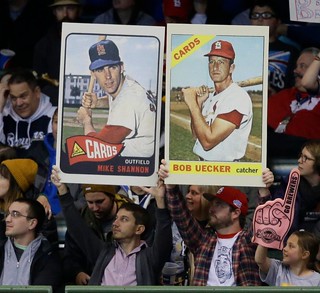 Fanatics has been dubbed the Amazon of sports because of its CEO Michael Rubin’s ambitions to become the central e-commerce platform for all corners of the sports entertainment market. Its success can be seen not only in its aspirations for a $100 billion market capitalization, but in the fact that Fanatics’ main competitor for control of apparel sales is now indeed Amazon. It has secured the financial interests of large institutional investors like SoftBank and celebrities like Jay-Z.
Fanatics has been dubbed the Amazon of sports because of its CEO Michael Rubin’s ambitions to become the central e-commerce platform for all corners of the sports entertainment market. Its success can be seen not only in its aspirations for a $100 billion market capitalization, but in the fact that Fanatics’ main competitor for control of apparel sales is now indeed Amazon. It has secured the financial interests of large institutional investors like SoftBank and celebrities like Jay-Z.
But it’s through a network of exclusive arrangements that Fanatics has asserted its dominance across the sports industry.







